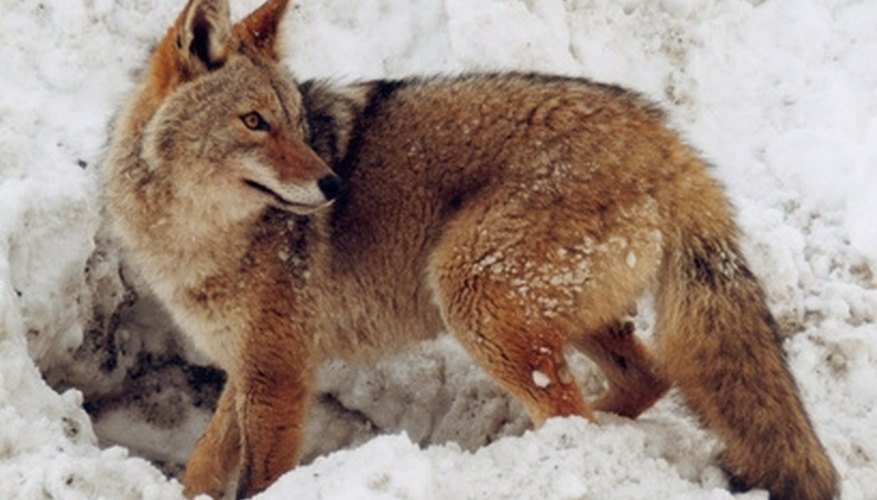
Coyotes have expanded their native range from being mostly a creature of the Western plains and deserts to establish populations in each of the contiguous states in the USA. Coyotes have also adapted to living in close proximity to humans in rural, suburban and even urban settings. As a result, interest in trapping coyotes as a recreational pursuit as well as to control their population is increasing. A cable restraint trap is effective, inexpensive and easy to construct.
Items you will need
Aircraft cable, 1/8 inch
Hex nuts, 1/4 inch
Flat washer, 3/8 inch
Hammer
Anvil
Vise
Drill bit, 5/32 inch
Wire cutters
Making the Restraint
Cut the 1/8 inch aircraft cable with wire cutters to a 48 inch length.
Drill a 5/32-inch hole at the 12 o'clock and 6 o'clock positions on the flat washer half way from the center hole of the washer to the outer edge of the washer.
Pinch the washer in a bench vise so half the washer extends above the jaws of the vise and half the washer is gripped by the vise. One of the drilled holes should be at the top, the other at the bottom.
Thread the aircraft cable through a 1/4-inch nut, then back through the nut going the opposite direction forming a loop in the cable. Tighten the loop until it's 3/4 inch in diameter.
Lay the nut with the cable running through it on edge on an anvil. Hammer the edge of the nut pinching it tightly across the strands of the cable, securing the loop.
Thread the end of the cable opposite the end with the 3/4-inch loop through one of the holes drilled in the washer from the outside of the bend. Pull 18 inches of the cable through the washer hole. Now thread the end of the cable through the other hole on the washer, this one from the inside of the bend to the outside.
Push the unlooped end of the cable through a 1/4-inch nut.
Place the nut on edge on an anvil with ½ inch of cable protruding through the center of the nut.
Hammer the edge of the nut until it flattens and grips tightly onto the strands of the cable.
Warnings
- Check with the wildlife management agency in the state in which you live to determine if, when or where cable restraints are allowed. A trapping license is usually required to set the restraints on land you don't personally own.
Tips
- To catch a coyote with a cable restraint, first find a trail you think a coyote will travel. Attach the small loop end of the cable to a solid object such as a stout sapling or fence post using heavy wire. Form the other end of the cable into a circular loop approximately 10 inches in diameter and suspend the loop from a convenient low-hanging branch or use a support wire to suspend the cable. Position the loop so the bottom of the loop hangs about 12 inches off the trail. When the coyote travels down the trail, it will mistake the cable for an innocent branch and push its head through the loop. The free-sliding loop will tighten down as the coyote continues down the trail, tightening around the animal's neck. The bent washer will prevent the loop from reopening.
References
Tips
- To catch a coyote with a cable restraint, first find a trail you think a coyote will travel. Attach the small loop end of the cable to a solid object such as a stout sapling or fence post using heavy wire. Form the other end of the cable into a circular loop approximately 10 inches in diameter and suspend the loop from a convenient low-hanging branch or use a support wire to suspend the cable. Position the loop so the bottom of the loop hangs about 12 inches off the trail. When the coyote travels down the trail, it will mistake the cable for an innocent branch and push its head through the loop. The free-sliding loop will tighten down as the coyote continues down the trail, tightening around the animal's neck. The bent washer will prevent the loop from reopening.
Warnings
- Check with the wildlife management agency in the state in which you live to determine if, when or where cable restraints are allowed. A trapping license is usually required to set the restraints on land you don't personally own.
Writer Bio
Mike Schoonveld has been writing since 1989 with magazine credits including "Outdoor Life," "Fur-Fish-Game," "The Rotarian" and numerous regional publications. Schoonveld earned a Master Captain License from the Coast Guard. He holds a Bachelor of Science in wildlife science from Purdue University.



